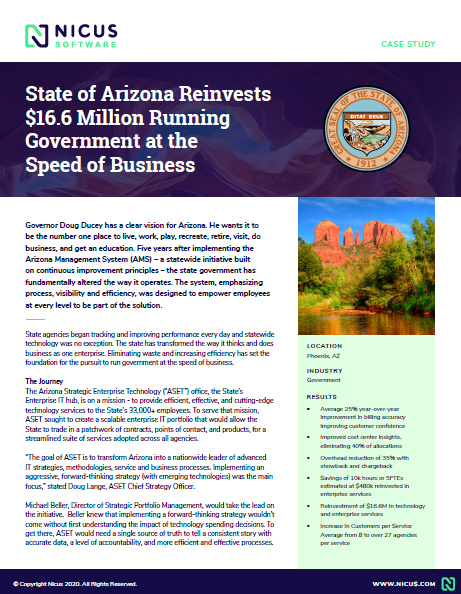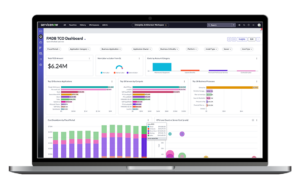Background
Governor Doug Ducey has a clear vision for Arizona. He wants it to be the number one place to live, work, play, recreate, retire, visit, do business, and get an education. Five years after implementing the Arizona Management System (AMS) – a statewide initiative built on continuous improvement principles – the state government has fundamentally altered the way it operates. The system, emphasizing process, visibility and efficiency, was designed to empower employees at every level to be part of the solution.
State agencies began tracking and improving performance every day and statewide technology was no exception. The state has transformed the way it thinks and does business as one enterprise. Eliminating waste and increasing efficiency has set the foundation for the pursuit to run government at the speed of business.
The Journey
The Arizona Strategic Enterprise Technology (“ASET”) office, the State’s Enterprise IT hub, is on a mission – to provide efficient, effective, and cutting-edge technology services to the State’s 33,000+ employees. To serve that mission, ASET sought to create a scalable enterprise IT portfolio that would allow the State to trade in a patchwork of contracts, points of contact, and products, for a streamlined suite of services adopted across all agencies.
“The goal of ASET is to transform Arizona into a nationwide leader of advanced IT strategies, methodologies, service and business processes. Implementing an aggressive, forward-thinking strategy (with emerging technologies) was the main focus,” stated Doug Lange, ASET Chief Strategy Officer.
Michael Beller, Director of Strategic Portfolio Management, would take the lead on the initiative. Beller knew that implementing a forward-thinking strategy wouldn’t come without first understanding the impact of technology spending decisions. To get there, ASET would need a single source of truth to tell a consistent story with accurate data, a level of accountability, and more efficient and effective processes.
Three years ago, the State selected Nicus through a competitive bid process to assist in the IT financial management (ITFM) journey because of its cost modeling and robust Bill of IT solutions. Beller has led the Nicus integration, which allowed the State to analyze inefficiencies and decide which IT products were performing, had strong adoption rates, and could be scaled to leverage better rate structures.
These changes have significantly impacted business operations for the better (e.g., increasing the IT Services Portfolio from $24M to $50M annually) including:
- Improved cost center insight, leading to a 40% reduction in allocations and greater product/service owner confidence
- Improved customer confidence with an average 25% year-over-year improvement in billing accuracy
- Overhead reduction by 35% with showback/chargeback by disclosing app, service, and business costs and accelerating customer invoice reconciliation
- Savings of 10k hours or 5 FTEs estimated at $480k with a single source of branding for all customers, engagement managers, and service owners (internal team previously utilizing up to six systems for information)
- Increase in Customers per Service Average from 8 to 27 agencies per service – better addressing customer needs and effectively scaling services, creating efficiencies, and achieving greatest return on investment (while moving away from reactive, service level agreements)
- Reinvestment of $16.6M in technology and enterprise services (through rate and volume analysis, total cost of ownership analysis, and cost optimization exercises)
“Since implementing Nicus, the greatest impact has been in customer confidence and satisfaction,” Beller noted. “Clarity equals confidence with our customers. They are armed with access and insight. No more wasting time with meetings and rework- and answering questions like ‘what’s in this rate?’”
Now that these changes have been made, Beller spends his time analyzing models and making predictions – focusing on the impact to the State. “Confidence in the data enables my team to influence decisions and align the organization,” Beller added.
The Future
As a result of the State’s initiative to run government at the speed of business, the Information Technology Financial Management (ITFM) program has reinvested $16.6M to other enterprise technologies and innovative services. Beller states he looks forward to the continued relationship with Nicus and driving financial maturity through service owner involvement. Exceeding customer expectations is only the beginning.
“COVID-19 has significantly increased the demand on government resources, challenging us to find new ways to do even more with less. We will continue to evolve the Enterprise IT service model ensuring that Arizona remains the very best place to live and work,” Beller concluded.





